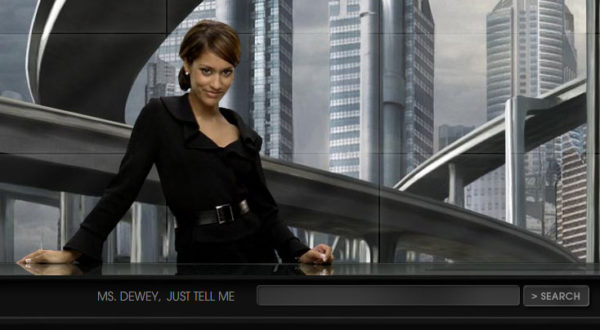In the mid-2000s, when search engines were becoming increasingly utilitarian and straightforward, Microsoft decided to take a bold, creative leap. Enter Ms. Dewey, a search engine unlike any other. Launched in 2006, Ms. Dewey wasn’t just a search engine; she was a fully interactive, personality-driven experience. With her witty remarks, playful demeanor, and visually rich interface, Ms. Dewey aimed to make searching the web an entertaining activity. But as with many ambitious projects, Ms. Dewey’s time in the spotlight was brief. Let’s explore the rise and fall of Ms. Dewey, a digital experiment that was ahead of its time.
The Birth of an Unconventional Search Engine
Ms. Dewey was introduced by Microsoft in October 2006, at a time when Google was rapidly solidifying its dominance in the search engine market. The concept behind Ms. Dewey was simple yet daring: make web searching not just a task but an experience. Instead of a plain, static search bar, users were greeted by Ms. Dewey, a lively, on-screen persona played by actress Janina Gavankar.
Ms. Dewey wasn’t just a virtual assistant; she was an interactive character who reacted to users’ search queries in real-time. Whether you were searching for information on ancient history or the latest celebrity gossip, Ms. Dewey would respond with a mix of humor, sass, and occasional sarcasm. The idea was to make the search process more engaging and, frankly, more human.
The Features and Interface
One of the most striking features of Ms. Dewey was its interface. Unlike the minimalist designs of Google or Yahoo, Ms. Dewey’s interface was full of visual flair. The screen was dominated by Ms. Dewey herself, who stood against a backdrop that changed depending on her mood or the nature of your search. As you typed in your query, Ms. Dewey would react—sometimes tapping impatiently, sometimes offering witty commentary, and other times performing short skits.

Ms. Dewey was also designed to simulate a conversation. After you entered a query, she would “speak” to you, reading out the search results or providing commentary. This was a stark contrast to the text-heavy results pages of other search engines at the time. Ms. Dewey could also deliver some interesting facts, trivia, or just playful banter, keeping the user entertained even if the search results weren’t what they were looking for.
But beneath the entertaining interface was a functional search engine. Ms. Dewey’s queries were powered by Microsoft’s search technology, which meant users were still getting relevant search results, even if the presentation was unorthodox.
Unknown Facts and Interesting Tidbits
- Janina Gavankar’s Role: Janina Gavankar, who played Ms. Dewey, filmed hundreds of video clips that were programmed to trigger based on user interactions. The sheer volume of pre-recorded responses gave Ms. Dewey an illusion of real-time interactivity that was quite advanced for its time.
- A Marketing Experiment: Although it functioned as a search engine, Ms. Dewey was also part of a larger marketing experiment by Microsoft. The company wanted to test the waters of interactive advertising, using Ms. Dewey’s persona to explore how entertainment could be integrated into everyday online tasks.
- Hidden Easter Eggs: Ms. Dewey’s database was filled with hidden Easter eggs—phrases or questions that would trigger unique, often humorous responses. For example, typing “What’s the meaning of life?” would prompt Ms. Dewey to quote the famous line from The Hitchhiker’s Guide to the Galaxy: “42.”
- Longevity of the Project: Although Ms. Dewey was introduced with much fanfare, the project was relatively short-lived. Microsoft quietly shut down the site in early 2009, just over two years after its launch. Despite this, Ms. Dewey gained a small but dedicated following, and to this day, she’s remembered as one of the most creative—if niche—search engines ever made.
The Reception
Ms. Dewey was met with mixed reactions. On the one hand, users praised the innovative and entertaining approach to web search. Many appreciated the break from the monotony of standard search engines, enjoying the playful and interactive nature of Ms. Dewey. It was refreshing to see a company take a risk on something so different.

On the other hand, some users found Ms. Dewey’s constant presence distracting. The time it took for her to respond to queries, while intended to be part of the entertainment, could be frustrating for those looking for quick results. In an era where efficiency was becoming increasingly important in digital experiences, the novelty of Ms. Dewey’s interactions sometimes felt like more of a hindrance than a help.
The Decline and Disappearance
By early 2009, Microsoft decided to retire Ms. Dewey. The search engine’s experimental nature meant that it was never intended to compete directly with giants like Google, and the growing demand for faster, more streamlined search experiences led to its quiet shutdown. While it was an interesting experiment in merging entertainment with utility, Ms. Dewey’s approach ultimately didn’t align with the direction in which search technology was heading.
Echoes in the Abyss
Today, the story of Ms. Dewey lingers as a curious footnote in the history of search engines. Though she’s gone, her presence echoes in the modern digital landscape—a reminder that technology can be more than just functional; it can be fun, engaging, and even a bit quirky.
Ms. Dewey’s ghost haunts the idea that searching for information doesn’t have to be a dry, mechanical process. She was a character full of personality, injecting life into the otherwise sterile world of search engines. In many ways, Ms. Dewey was ahead of her time, experimenting with concepts of interactive search and virtual personas long before they became mainstream.
While she may have vanished from our screens, the spirit of Ms. Dewey lives on in today’s virtual assistants and interactive technologies. She stands as a testament to the power of creativity in tech—a reminder that sometimes, taking a risk and doing something different, even if it doesn’t last, can leave a lasting impression.
So, though Ms. Dewey may have disappeared into the abyss, her story remains a unique chapter in the annals of digital history, where innovation and entertainment collided in a way that was as memorable as it was fleeting.
Thank you for joining us on “Into the Abyss,” where we uncover the rise and fall of forgotten digital titans, one byte at a time. From audacious innovations to their ultimate legacies, stay tuned as we continue exploring the stories that shaped our digital world. Until next time, keep dreaming beyond the horizon with us.